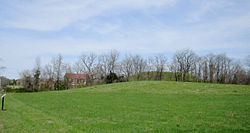 Fewkes Mounds No. 1 & 2. Boiling Spring Academy in the background | |
| Location | Williamson County, Tennessee, |
|---|---|
| Region | Williamson County, Tennessee |
| Coordinates | 35°58′0.44″N 86°46′34.54″W / 35.9667889°N 86.7762611°W |
| History | |
| Founded | 1050 |
| Abandoned | 1475 |
| Cultures | Mississippian culture |
| Site notes | |
| Excavation dates | 1920 |
| Archaeologists | William E. Myer |
| Architecture | |
| Architectural styles | burial mounds, platform mounds, plaza |
| Responsible body: City of Brentwood | |
Fewkes Group Archaeological Site (40 WM 1), also known as the Boiling Springs Site,[1] is a pre American history Native American archaeological site located in the city of Brentwood, in Williamson County, Tennessee. It is in Primm Historic Park on the grounds of Boiling Spring Academy, a historic schoolhouse established in 1830. The 15-acre site consists of the remains of a late Mississippian culture mound complex and village roughly dating to 1050-1475 AD.[2] The site, which sits on the western bank of the Little Harpeth River, has five mounds, some used for burial and others, including the largest, were ceremonial platform mounds.[3] The village was abandoned for unknown reasons around 1450.[2] The site is named in honor of Dr. J. Walter Fewkes, the Chief of the Bureau of American Ethnology in 1920, who had visited the site and recognized its potential.[4] While it was partially excavated by the landowner in 1895, archaeologist William E. Myer directed a second, more thorough excavation in October 1920.[3] The report of his findings was published in the Bureau of American Ethnology's Forty-First Annual Report.[5] Many of the artifacts recovered from the site are now housed at the Smithsonian Institution. It was added to the National Register of Historic Places on April 21, 1980, as NRIS number 80003880.[6]
- ^ Peres, Tanya M. (2010). Michael C. Moore (ed.). "Zooarchaeological remains from the 1998 Fewkes Site excavations, Williamson County, Tennessee" (PDF). Tennessee Archaeology. 5 (1). Tennessee Council for Professional Archaeology: 100–125. Archived from the original (PDF) on July 16, 2011. Retrieved April 16, 2011.
- ^ a b Hutt, Sherry (August 3, 2010). "Notice of Inventory Completion: Tennessee Department of Environment and Conservation, Division of Archaeology, Nashville, Tennessee". Federal Register. Retrieved April 11, 2011.
- ^ a b Warwick, Rick (2010). Historical Markers of Williamson County Tennessee, Revised: A Pictorial Guide. Nashville, Tennessee: Panacea Press.
- ^ Little, Vance (1985). Historic Brentwood. Brentwood, Tennessee: J M Publications.
- ^ Myer, William (1928). Two Prehistoric Villages in Middle Tennessee. Nashville, Tennessee: Southeastern Indian Antiquities Survey, Inc. pp. 559–610.
- ^ "National Register of Historic Places". Archived from the original on August 3, 2012. Retrieved April 16, 2011.
